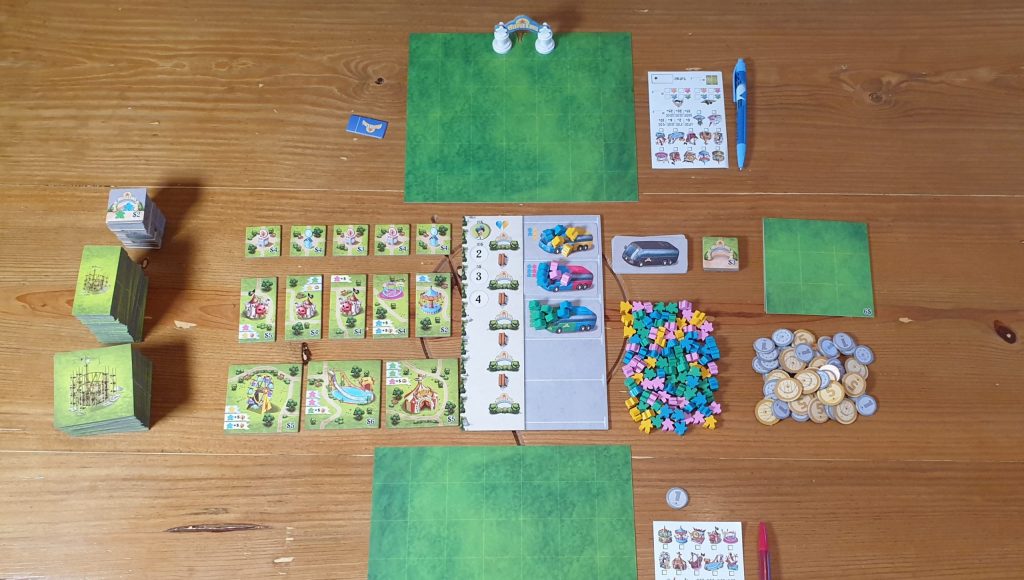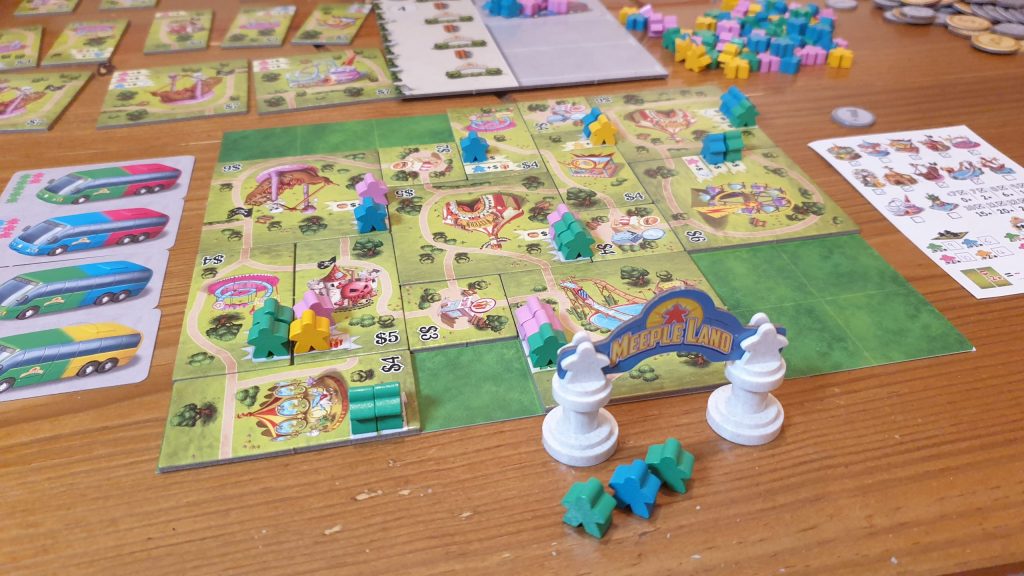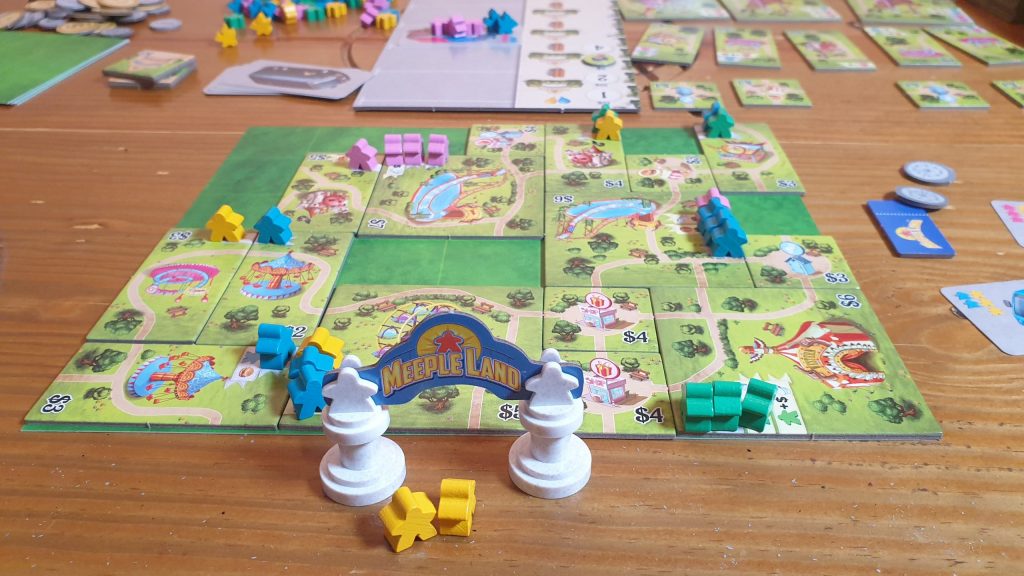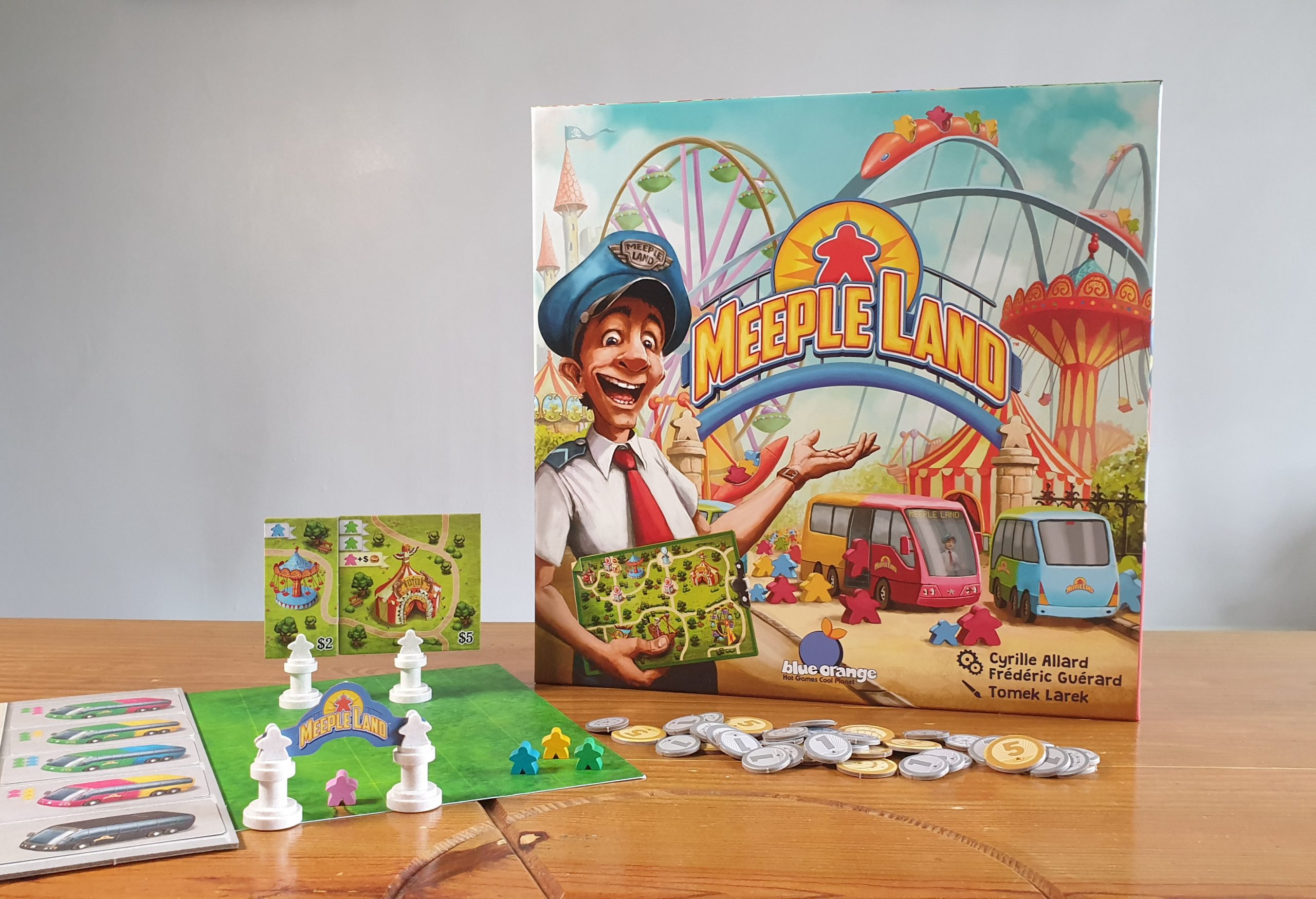Meeple Land is a brand new amusement park themed tile placement board game, from publisher Blue Orange Games. Designed by Cyrille Allard and Frédéric Guérard, featuring artwork from Tomasz Larek, the game sees 2 – 4 players attempting to build the best park for bus loads of colourful meeples. Lasting around 35 minutes, paths will wiggle throughout the parks, past roller coasters, flat rides and services. However, will players want to visit the parks of Meeple Land? Let’s find out!
Starting off each player takes an empty park board and constructs a park entrance for their park. The last player to have visited an amusement park takes the first player token, with bonus funds distributed out depending on turn order. A market of the three different sized tiles and the bus parking lot board are filled, and then the game is ready to play. Played over four rounds each starts with players checking the grant level. In round 1 this starts at $15 for all players, before slowly dropping round by round to $0 for round 4. With money in hand it is then time to take turns, beginning with the starting player.
On a turn a player must perform 1 of 3 actions: buy, advertise or pass. Buying a tile sees the denoted cost paid, which is roughly linked to the tile size and visitor opportunities. Tiles are instantly placed into the park, and once placed cannot be moved. There are rules to follow. At least one path must continue from a previous tile in the park and the tiles cannot overlap others or the edge of the board. If a player cannot place a tile they cannot buy it. Thankfully, there are additional park entrances always available to buy in case a player has no paths to build on from. Otherwise any tile can be built adjacent to any other, though building service tiles adjacent to rides can sometimes unlock additional spaces to send guests to later on.

Whenever a tile is purchased the next tile from the same sized tile pile is flipped to restock the market. Whilst not mandatory during the game, players can use a scoresheet and tick off the unique rides as they add them into their park. On the reverse side of the 1 x 1 sized tiles are advertisements, so when a 1 x 1 square tile is purchased the available advertisement is also refreshed. Instead of buying a tile players can choose to pay for this advertisement, receiving the indicated visitor meeples from the supply.
When out of funds or whenever they want to a player can choose to pass, though they then won’t have any more involvement in the round. At this point the player gets to choose one of the buses from the parking lot. Taking the meeples on board they now flood into the player’s park. At any point during the round, players are free to leave their visitor meeples outside of the park or arrange them on the spaces on tiles, by matching the meeple colour. At the end of the round players must commit to where the visitors are though. Money is then earnt, $1 for each meeple in the park, with some spaces offering an extra $1 if filled. The game then continues with the next round, with the first player token claimed by whomever has the least money.
At the end of the game players don’t gain money. Instead, players earn points for every meeple inside the park and lose points based on those left outside, based on the meeple colour. Players then gain points from the number of unique rides built and lose points for paths cut off by other tiles. Whomever has the most points after this is the winner, with ties split by whomever lost the least points.

Having the first player of each round determined by the least money is a decent catch up mechanism. It gives that player that is behind a bit of a boost, getting the first choice of hopefully good tiles. It also results in them most probably being the first to pass for the round, thus choosing a bus of meeples before the others. This is because while you can pass at any point most keep spending until they are unable to buy more! Players will be building their parks with an eye on one of those buses. So, ending first and taking the exact one you want can often help – as well as potentially hinder an opponent.
While less of an issue with an increased player count, at two players the market of tiles can become a little stale. By no means is this in every play, as there are often interesting choices of what tiles to purchase, due to the meeple spaces on offer and the paths on them. There were a few points where a wall was hit though, where neither player really wanted anything from the display. This could see a player forced to buy a tile or pass, opening up the opportunity for the next player to get a different and sort after tile straight away. At this point the ability to pay for advertisements comes into play, though that doesn’t help refresh the market in any way.
As an action the advertisement is one that was frequently avoided. In theory the ability to gain a couple of meeples for your park is a strong choice. In reality none of us ever felt like we needed more meeples than were gained from the buses. In part this is because the number of points lost for unhappy meeples, left outside the park, is something no one wants to endure. The fountains offer some kind of a solution to this, allowing a meeple of any colour to be placed on them. They are not guaranteed to surface though if players don’t keep buying the small square tiles. If a selection of these tiles were always available then players might have felt more comfortable overextending and gaining meeples they couldn’t use.

When it comes to the illustrations of the rides, they are reused across a number of the tiles. This is due to the way that players are attempting to build one of each ride in the park. Thankfully, some of the details like paths, benches and trees are mixed up giving some variety. Nevertheless, it feels like a missed opportunity to not have a range of ride themes – seeing sci-fi, western or more dodgem cars for example. Sticking with one illustration for each ride does help the readability of the parks, so it isn’t without merit.
The tiles, which are the main event of Meeple Land, are of good thickness – and aside from shuffling they don’t exactly get thrown around. Including a pad of scoresheets makes pointing up at the end a breeze. It’s great to see that this pad is double sided too, allowing it to last that bit longer. Making the park entrances look that little extra special are 3D entrance archways. Sitting just off the board they don’t get in the way and catch peoples’ eyes. Aside from that little extra visual interest they don’t add much though, so I can see them being left in the box by most after a few plays. Oddly the plot and plot extension boards are thin card while even the parking lot board is from a punch sheet. Like with the main tiles though they aren’t put through anything strenuous, so they don’t need any more robustness.
Meeple Land is on the simple side of tile placement games, making it ideal for families. There are choices along the way, with unique rides to aim for, whilst balancing money and the colour of meeples coming to the park. The way the paths work can be a little punishing for those not paying attention. Mostly though there is a relaxed vibe to slowly buying tiles and filling out your amusement park. Scoring is relatively intuitive, players want more unique rides and to welcome as many meeples in as possible. The game does lack bonus objectives that could make each game feel different, which could also make it more of a “gamers” game. Meeple Land is therefore one to pull out with the family at Christmas, or with a group of friends looking for a more chilled tile placement experience.
(Editor’s Note: Meeple Land was provided to us by Coiledspring Games for the review. The game is currently available from local board game stores! Find your local store here.)

